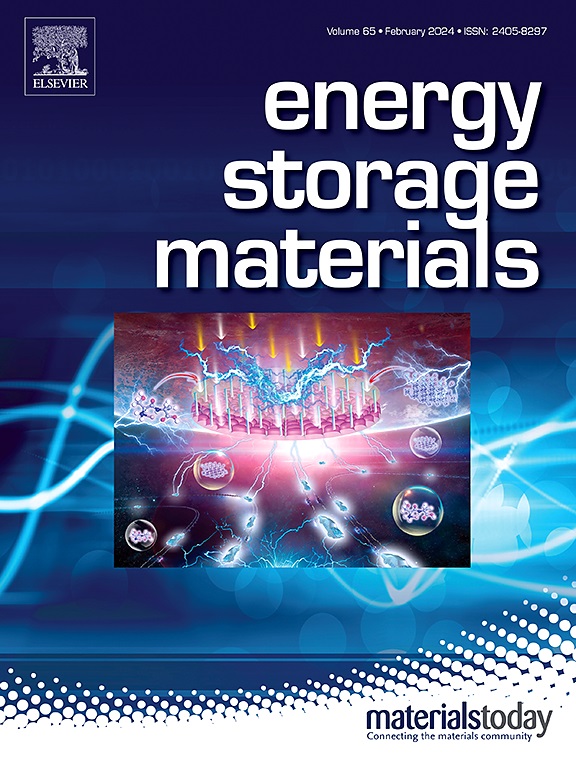Aluminum-cobalt-nickel trimetallic oxyhydroxide cathodes for high-energy-density aqueous magnesium-ion batteries
IF 20.2
1区 材料科学
Q1 CHEMISTRY, PHYSICAL
引用次数: 0
Abstract
The growing demand for efficient and sustainable energy storage systems has accelerated research into aqueous magnesium-ion batteries (AMIBs). However, the development of AMIBs faces cathode-related challenges including sluggish Mg2+diffusion kinetics, limited energy density and poor cycling stability. In this study, we synthesize a novel aluminum-cobalt-nickel trimetallic oxyhydroxide (ACNOOH) cathode material designed to overcome these limitations through strategic modification of nickel oxyhydroxide (NiOOH) with aluminum and cobalt. By regulating the electronic structure of the cathode material, aluminum lowers its Fermi level, thereby increasing the discharge voltage and energy density, and cobalt element mitigates the loss of Ni3+ during the cycle, thereby enhancing the cycling performance. Compared to NiOOH, ACNOOH exhibits superior energy density, improved rate performance, and enhanced cycling stability. The energy densities of the fabricated AMIBs are 127.07 Wh kg-1 at 1 A g-1 and 74.25 Wh kg-1 at 5 A g-1 with excellent capacity retention. These results indicate that ACNOOH can significantly improve the energy density and stability of AMIBs, which is a promising cathode material,and the present work offers a feasible elemental modification strategy for next-generation energy storage systems.
高能量密度水镁离子电池用铝钴镍三金属氢氧化物阴极
对高效和可持续能源存储系统日益增长的需求加速了对水镁离子电池(amib)的研究。然而,amib的发展面临着与阴极相关的挑战,包括缓慢的Mg2+扩散动力学,有限的能量密度和较差的循环稳定性。在这项研究中,我们通过铝和钴对氧化镍(NiOOH)进行战略性改性,合成了一种新的铝钴镍三金属氢氧化物(ACNOOH)阴极材料,旨在克服这些限制。通过调节正极材料的电子结构,铝降低了其费米能级,从而提高了放电电压和能量密度,钴元素减轻了循环过程中Ni3+的损失,从而提高了循环性能。与NiOOH相比,ACNOOH具有更高的能量密度、更高的速率性能和更强的循环稳定性。制备的amib在1 A g-1和5 A g-1下的能量密度分别为127.07 Wh kg-1和74.25 Wh kg-1,具有良好的容量保持性能。这些结果表明,ACNOOH可以显著提高amib的能量密度和稳定性,这是一种很有前途的正极材料,本工作为下一代储能系统提供了可行的元素修饰策略。
本文章由计算机程序翻译,如有差异,请以英文原文为准。
求助全文
约1分钟内获得全文
求助全文
来源期刊

Energy Storage Materials
Materials Science-General Materials Science
CiteScore
33.00
自引率
5.90%
发文量
652
审稿时长
27 days
期刊介绍:
Energy Storage Materials is a global interdisciplinary journal dedicated to sharing scientific and technological advancements in materials and devices for advanced energy storage and related energy conversion, such as in metal-O2 batteries. The journal features comprehensive research articles, including full papers and short communications, as well as authoritative feature articles and reviews by leading experts in the field.
Energy Storage Materials covers a wide range of topics, including the synthesis, fabrication, structure, properties, performance, and technological applications of energy storage materials. Additionally, the journal explores strategies, policies, and developments in the field of energy storage materials and devices for sustainable energy.
Published papers are selected based on their scientific and technological significance, their ability to provide valuable new knowledge, and their relevance to the international research community.
 求助内容:
求助内容: 应助结果提醒方式:
应助结果提醒方式:


